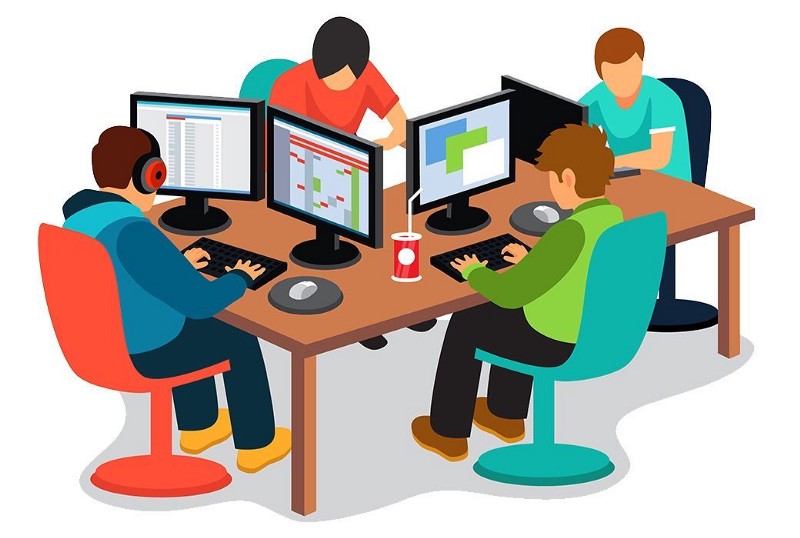اعضای یک تیم توسعه که در یک مکان فیزیکی یکسان قرار دارند و همکاری رو در رو بین اعضای تیم ممکن و عملی است.
هممحل بودن برای جلساتی که نیاز به گوش دادن دقیق دارند، مانند بحثهای طراحی، مفید است. همچنین زمانی که کارمندان جدید در حال آموزش هستند و به مقداری راهنمایی یا تشویق نیاز دارند، بسیار کارآمد است. تخته سفید برای تیم هممحل بسیار مؤثر است اما میتوان آن را با ابزارهای آنلاین نیز مدیریت کرد.
بسیاری از مردم فراموش کردهاند که کار کردن با یک تیم هممحل چه احساسی دارد و افزایش تولیدی که در آن وجود دارد را تجربه کنند. بیشتر مردم این مفهوم را درک میکنند، اما ممکن است اصول زیرین آن را نفهمند. در اینجا چند مزیت تیم هممحل آورده شده است:
- افزایش سرعت و اثربخشی ارتباطات رو در رو، به ویژه از طریق حرکات بدن، تن صدا، حالات چهره و غیره.
- سهولت در استفاده از ابزارهای ساده برای برنامهریزی و ارتباط — مانند تختههای سفید و یادداشتهای چسبان.
- سهولت در روشنسازی فوری سوالات. درک اینکه سایر اعضا بر روی چه چیزی کار میکنند.
- سهولت در حمایت از سایر اعضای تیم در وظایفشان. صرفهجویی در هزینه به دلیل کاهش زمانهای تأخیر و سوءتفاهمهای کمتر که منجر به نقص یا کار هدر رفته میشود.

شواهد آماری
ارزش ارتباطات رو در رو نباید دست کم گرفته شود. آلبرت مهرابیان، دکترای روانشناسی و استاد بازنشسته دانشگاه UCLA، شواهد آماری زیر را برای حمایت از مزایای تیم هممحل اثبات کرد:
۵۵ درصد از معنا از طریق زبان بدن و حالات چهره منتقل میشود.
۳۸ درصد از معنا پارا زبانی است (از طریق نحوه صحبت کردن ما منتقل میشود).
۷ درصد از معنا در کلمات واقعی بیان شده منتقل میشود.
مقالات دیگر پیشنهادی اسکرام
اعضای یک تیم توسعه که در یک مکان فیزیکی یکسان قرار دارند و همکاری رو در رو بین اعضای تیم ممکن و عملی است.
هممحل بودن برای جلساتی که نیاز به گوش دادن دقیق دارند، مانند بحثهای طراحی، مفید است. همچنین زمانی که کارمندان جدید در حال آموزش هستند و به مقداری راهنمایی یا تشویق نیاز دارند، بسیار کارآمد است. تخته سفید برای تیم هممحل بسیار مؤثر است اما میتوان آن را با ابزارهای آنلاین نیز مدیریت کرد.
بسیاری از مردم فراموش کردهاند که کار کردن با یک تیم هممحل چه احساسی دارد و افزایش تولیدی که در آن وجود دارد را تجربه کنند. بیشتر مردم این مفهوم را درک میکنند، اما ممکن است اصول زیرین آن را نفهمند. در اینجا چند مزیت تیم هممحل آورده شده است:
- افزایش سرعت و اثربخشی ارتباطات رو در رو، به ویژه از طریق حرکات بدن، تن صدا، حالات چهره و غیره.
- سهولت در استفاده از ابزارهای ساده برای برنامهریزی و ارتباط — مانند تختههای سفید و یادداشتهای چسبان.
- سهولت در روشنسازی فوری سوالات. درک اینکه سایر اعضا بر روی چه چیزی کار میکنند.
- سهولت در حمایت از سایر اعضای تیم در وظایفشان. صرفهجویی در هزینه به دلیل کاهش زمانهای تأخیر و سوءتفاهمهای کمتر که منجر به نقص یا کار هدر رفته میشود.

شواهد آماری
ارزش ارتباطات رو در رو نباید دست کم گرفته شود. آلبرت مهرابیان، دکترای روانشناسی و استاد بازنشسته دانشگاه UCLA، شواهد آماری زیر را برای حمایت از مزایای تیم هممحل اثبات کرد:
۵۵ درصد از معنا از طریق زبان بدن و حالات چهره منتقل میشود.
۳۸ درصد از معنا پارا زبانی است (از طریق نحوه صحبت کردن ما منتقل میشود).
۷ درصد از معنا در کلمات واقعی بیان شده منتقل میشود.
مقالات دیگر پیشنهادی اسکرام
This post is also available in Deutsch, English, Español, Français, Bahasa Indonesia, 日本語, Polski, Portuguese, Ру́сский, Việt Nam, 简体中文 and 繁體中文.













